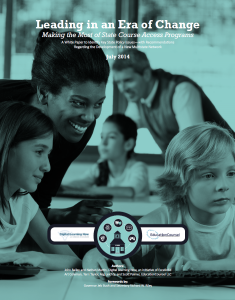A new report says the time has come for states to work together to manage the mix of new options that could soon be available to students through digital learning.
The report by Digital Learning Now calls on state policymakers to “formalize the establishment of a multi-state network, focused on Course Access programs.”
“Course choice” or “course access” is the next wave in educational choice. In Florida, for example, it won’t be long before students who can’t take, say, a physics or calculus course at their local high school can browse an online course catalog, find a class that works for them, and enroll.
Some might already be able to do that with courses available through Florida Virtual School or a virtual program run by their district. But the state Department of Education is developing an online course catalog that will allow them to choose from a wider range of options. Due to legislative changes approved in 2013, courses offered in other school districts could also be on the menu. And still other new providers could soon start offering classes through the state’s nascent course choice system.
Florida isn’t alone. States are developing new digital learning programs that expand education options in several ways, notes the report by Digital Learning Now (an effort of the Foundation for Excellence in Education, which is chaired by former Gov. Jeb Bush). As they do so, they can create new entrepreneurial opportunities for teachers, expand systems that allow students to learn at their own pace, and give school districts a new way to grow enrollment by attracting students outside their geographic boundaries.
Digital learning advocates have started to coalesce around the term “course access.” Only about half of U.S. high schools offer calculus, according to a recent report by the U.S. Department of Education, and less than two thirds offer physics. If they’re managed properly, and made accessible to students who need them the most, new digital learning policies have the potential to allow students to take courses that aren’t available on their physical campuses.
The DLN report tries to push the discussion a step further. If blurring geographic boundaries between school districts can expand the number of options available, why not allow the programs to cross state lines too?
As states like Florida move from a virtual education landscape that revolves around a central virtual school to one that supports a host of other course providers, they’re going to have to come up with systems to screen would-be providers and monitor their performance. They might be better able to manage that complexity if they collaborate.
The report says states “might be able to create more comprehensive, efficient, and effective monitoring mechanisms by working together” – especially for providers that operate at a national scale and might need to get approval in multiple states anyway. If groups of similarly-situated states worked together voluntarily, they could increase the number of options available to students in individual states, and give states “time, resources, and innovative thinking that states may not have working alone.”
There’s a tension here, which has emerged in recent legislative debates in Florida. Online courses aren’t subject to geographic boundaries, but there are boundaries in state laws, including requirements that digital learning providers receive state certification for their teachers or establish a physical presence in the state. The digital learning legislation passed in 2013 kept many of those requirements in place.
The report says states should consider “reciprocity” agreements, which many states already have for teacher certification, that would allow providers to offer courses in other states, and make it easier for individual states to judge the quality of new providers. If a provider gets approval from one state, another state might not have to accept it. But the state might choose to “fast track” that provider, knowing it meets a certain standard. That model, along with agreements between states for distance learning in higher education, “could also serve as model for inter-state collaboration, monitoring, and program evaluation in Course Access programs.”




[…] Read the source article at RedefinED Online […]